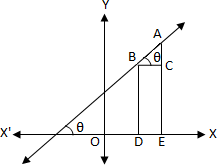Subscribe to our ▶️ YouTube channel 🔴 for the latest videos, updates, and tips.
Slope of a Line through Two Given Points
How to find the slope of a line through two given points?
Let (x\(_{1}\), y\(_{1}\)) and (x\(_{2}\), y\(_{2}\)) be two given cartesian co-ordinates of the point A and B respectively referred to rectangular co-ordinate axes XOX' and YOY'.
Again let the straight line AB makes an angle θ with the positive x-axis in the anticlockwise direction.
Now by definition, the slope of the line AB is tan θ.
Therefore, we have to find the value of m = tan θ.
Draw AE and BD perpendiculars on x-axis and from B draw BC perpendiculars on AE. Then,
AE = y\(_{1}\), BD = y\(_{2}\), OE = x\(_{1}\) and OD = x\(_{2}\)
Therefore, BC = DE = OE - OD = x\(_{1}\) - x\(_{2}\)
Again, AC = AE - CE = AE - BD = y\(_{1}\) - y\(_{2}\)
<ABC = θ, since, BC parallel to x-axis.
Therefore, from the right angle ∆ABC we get,
tan θ = \(\frac{AC}{BC}\) = \(\frac{y_{1} - y_{2}}{x_{1} - x_{2}}\)
⇒ tan θ = \(\frac{y_{2} - y_{1}}{x_{2} - x_{1}}\)
Therefore, the required slop of the line passing through the points A (x\(_{1}\), y\(_{1}\)) and B (x\(_{2}\), y\(_{2}\)) is
m = tan θ = \(\frac{y_{2} - y_{1}}{x_{2} - x_{1}}\) = \(\frac{\textrm{Difference of ordinates of the given point}}{\textrm {Difference of abscissa of the given point}}\)
Solved example to find the slope of a line passes through two given points:
Find the slope of a straight line which passes through points (-5, 7) and (-4, 8).
Solution:
We know that the slope of a straight line passes through two points (x\(_{1}\), y\(_{1}\)) and (x\(_{2}\), y\(_{2}\)) is given by m = \(\frac{y_{2} - y_{1}}{x_{2} - x_{1}}\). Here the straight line passes through (-5, 7) and (-4, 8). Therefore, the slope of the straight line is given by m = \(\frac{8 - 7}{-4 - (-5) }\) = \(\frac{1}{-4 + 5}\) = \(\frac{1}{1}\) = 1
Note:
1. Slop of two parallel lines are equal.
2. Slope of x-axis or slope of a straight line parallel to x-axis is zero, since we know that tan 0° = 0.
3. Slop of y-axis or slope of a straight line parallel to y-axis is undefined, since we know that tan 90° is undefined.
4. We know that co-ordinate of the origin is (0, 0). If O be the origin and M (x, y) be a given point, then the slope of the line OM is \(\frac{y}{x}\).
5. The slop of the line is the change in the value of ordinate of any point on the line for unit change in the value of abscissa.
● The Straight Line
- Straight Line
- Slope of a Straight Line
- Slope of a Line through Two Given Points
- Collinearity of Three Points
- Equation of a Line Parallel to x-axis
- Equation of a Line Parallel to y-axis
- Slope-intercept Form
- Point-slope Form
- Straight line in Two-point Form
- Straight Line in Intercept Form
- Straight Line in Normal Form
- General Form into Slope-intercept Form
- General Form into Intercept Form
- General Form into Normal Form
- Point of Intersection of Two Lines
- Concurrency of Three Lines
- Angle between Two Straight Lines
- Condition of Parallelism of Lines
- Equation of a Line Parallel to a Line
- Condition of Perpendicularity of Two Lines
- Equation of a Line Perpendicular to a Line
- Identical Straight Lines
- Position of a Point Relative to a Line
- Distance of a Point from a Straight Line
- Equations of the Bisectors of the Angles between Two Straight Lines
- Bisector of the Angle which Contains the Origin
- Straight Line Formulae
- Problems on Straight Lines
- Word Problems on Straight Lines
- Problems on Slope and Intercept
11 and 12 Grade Math
From Slope of a Line through Two Given Points to HOME PAGE
Didn't find what you were looking for? Or want to know more information about Math Only Math. Use this Google Search to find what you need.



New! Comments
Have your say about what you just read! Leave me a comment in the box below. Ask a Question or Answer a Question.